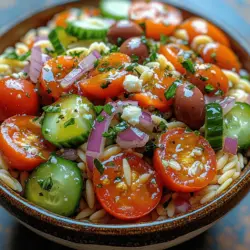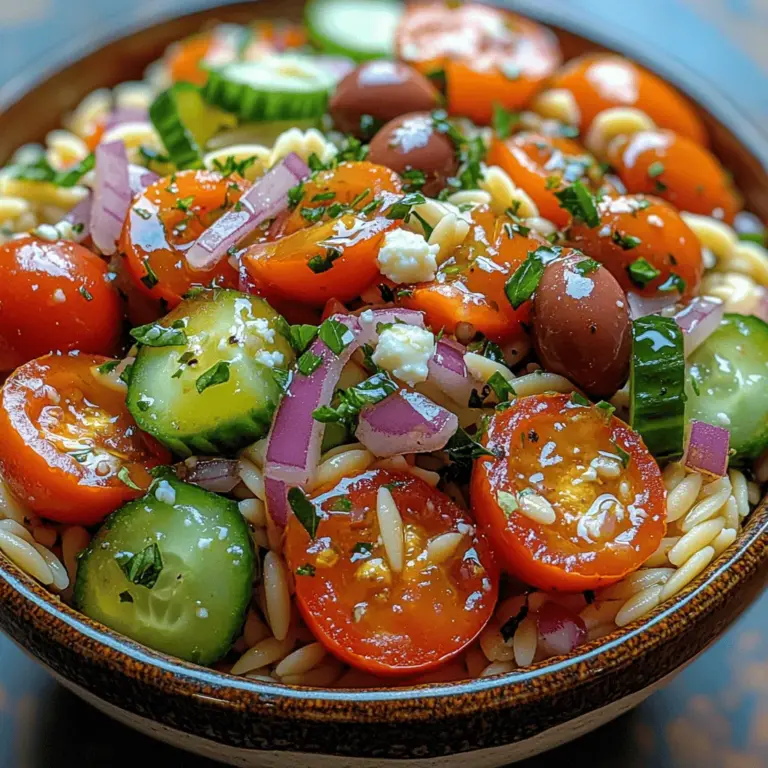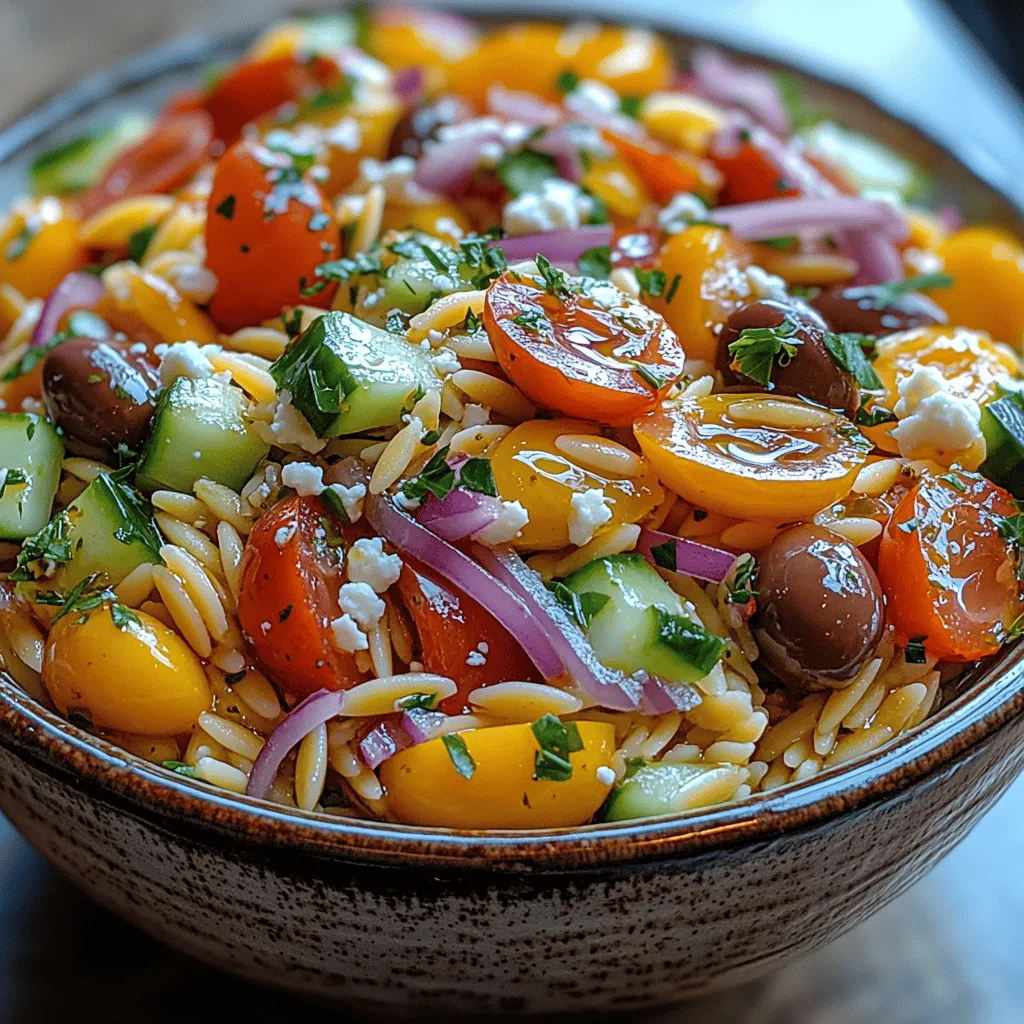Introduction to Mediterranean Bliss: Feta and Tomato Orzo Salad
In the realm of culinary delights, Mediterranean cuisine stands out for its vibrant flavors, fresh ingredients, and wholesome dishes. One such dish that embodies these qualities is the Mediterranean Bliss: Feta and Tomato Orzo Salad. This refreshing salad not only makes for a delightful accompaniment to any meal but can also serve as a light main course, perfect for warm weather or any occasion that calls for a burst of flavor.
The Mediterranean Bliss: Feta and Tomato Orzo Salad is a harmonious blend of textures and tastes—creamy feta, juicy tomatoes, crunchy cucumbers, and briny olives, all enveloped in the delightful shape of orzo pasta. The salad is not only visually appealing but also packs a nutritional punch, making it a great choice for health-conscious individuals. In this article, we will delve into the intricacies of this recipe, exploring its ingredients, preparation steps, and the cultural significance of each component, allowing you to appreciate the depth of flavor and history behind this Mediterranean classic.
The Allure of Mediterranean Cuisine
Exploring the Fundamentals of Mediterranean Diet
The Mediterranean diet is frequently lauded for its health benefits and is often regarded as one of the healthiest dietary patterns in the world. It emphasizes fresh vegetables, whole grains, legumes, nuts, and healthy fats, particularly olive oil, while also incorporating moderate amounts of fish, poultry, dairy, and red wine. This diet is not merely about what one eats; it represents a lifestyle that promotes conviviality, enjoyment, and balance.
Research has shown that adhering to a Mediterranean diet can lead to numerous health benefits, including reduced risk of heart disease, improved cognitive function, and better weight management. The abundance of antioxidants from fruits and vegetables, combined with healthy fats, contributes to overall well-being, making dishes like the Feta and Tomato Orzo Salad not just delicious but also nourishing.
Cultural Significance of Feta and Olives
Feta cheese and olives are two staples of Mediterranean cuisine that hold significant cultural importance. Feta, a brined curd cheese originating from Greece, is celebrated for its tangy flavor and crumbly texture. Traditionally made from sheep’s milk or a mixture of sheep and goat’s milk, feta has a rich history that dates back to ancient times. It is often used in various dishes, from salads to pastries, and is a key ingredient in the famous Greek salad.
Olives, particularly Kalamata olives, are another essential component of Mediterranean cooking. Their deep, fruity flavor and unique texture elevate dishes while providing healthy fats and antioxidants. Olives have been cultivated for thousands of years, playing an integral role in the diets and cultures of Mediterranean peoples. They are not only enjoyed whole but also pressed to produce olive oil, which is a cornerstone of Mediterranean culinary practices.
Ingredient Spotlight
Understanding the ingredients used in the Mediterranean Bliss: Feta and Tomato Orzo Salad is crucial for appreciating its flavor profile and nutritional benefits. Let’s explore each component in detail.
Orzo Pasta
Orzo is a type of pasta that resembles large grains of rice, making it a versatile addition to various dishes. Originating from Italy, the name “orzo” translates to “barley” in Italian, though it is actually made from semolina flour. Nutritionally, orzo is a good source of carbohydrates, providing energy for the body, and is often enriched with vitamins and minerals. When cooked properly, orzo adds a delightful chewiness to the salad, serving as the perfect base for the other ingredients.
Cherry Tomatoes
Fresh cherry tomatoes are a highlight of this salad, offering a burst of sweetness and acidity that pairs beautifully with the feta cheese. They are rich in vitamins A and C, potassium, and antioxidants, making them a healthful addition. While canned tomatoes can be convenient, fresh cherry tomatoes provide superior flavor and texture. Their vibrant color also enhances the visual appeal of the dish, making it even more inviting.
Cucumber
Cucumber adds a refreshing crunch to the Mediterranean Bliss: Feta and Tomato Orzo Salad. This hydrating vegetable is low in calories and high in water content, making it an excellent choice for those looking to maintain hydration. Additionally, cucumbers contain vitamins K and C, as well as antioxidants. When diced and mixed into the salad, cucumbers provide a crisp contrast to the creaminess of the feta and the sweetness of the tomatoes.
Red Onion
The inclusion of red onion introduces a savory depth to the salad. Known for its mild yet distinct flavor, red onion contributes a slight sharpness that balances the sweetness of the tomatoes and the saltiness of the feta. Rich in antioxidants and vitamins, red onions also offer anti-inflammatory properties, making them a nutritious choice. Slicing them thinly allows their flavor to infuse the salad without overwhelming the palate.
Feta Cheese
Feta cheese is undoubtedly the star of the Mediterranean Bliss: Feta and Tomato Orzo Salad. Its crumbly texture and tangy flavor elevate the dish, providing a creamy element that complements the other ingredients. When selecting feta, it’s essential to choose high-quality cheese made from sheep’s milk for the best flavor. Feta can vary in saltiness and creaminess depending on its production process, so taste-testing different varieties can lead to delightful discoveries.
Kalamata Olives
Kalamata olives bring a rich, briny flavor to the salad, enhancing its Mediterranean essence. These dark purple olives are known for their almond shape and bold taste, which can add a savory depth to any dish. Nutritionally, olives are high in healthy monounsaturated fats, antioxidants, and anti-inflammatory compounds. When pitted and sliced, Kalamata olives provide a pop of flavor in every bite, making them an essential ingredient in this salad.
Fresh Herbs
Fresh herbs, particularly parsley and basil, play a crucial role in Mediterranean cooking. They not only add vibrant flavor but also provide aromatic qualities that enhance the overall taste of the salad. Parsley is rich in vitamins A, C, and K, while basil offers anti-inflammatory and antioxidant benefits. Chopping these herbs finely and incorporating them into the salad introduces a fresh, green element that brightens the dish and ties all the flavors together.
Dressing Components
The dressing for the Mediterranean Bliss: Feta and Tomato Orzo Salad is simple yet essential, comprising high-quality olive oil and red wine vinegar. Olive oil serves as a heart-healthy fat that enhances the richness of the salad, while red wine vinegar adds acidity and brightness. This combination not only helps to meld the flavors of the salad ingredients but also contributes to the overall health benefits associated with the Mediterranean diet.
Step-by-Step Preparation
Now that you are familiar with the ingredients that make up the Mediterranean Bliss: Feta and Tomato Orzo Salad, let’s move on to the preparation. Here’s a detailed guide on crafting the perfect salad, starting with cooking the orzo.
Cooking the Orzo
1. Boil Water: Begin by bringing a large pot of salted water to a rolling boil. The salt enhances the flavor of the orzo as it cooks.
2. Add Orzo: Once the water is boiling, add the orzo pasta. Stir it gently to prevent sticking.
3. Cook Until Al Dente: Follow the package instructions for cooking time, typically around 8-10 minutes. You want the orzo to be cooked al dente, which means it should be tender but still firm to the bite.
4. Drain and Rinse: After the orzo is cooked, drain it in a colander. To stop the cooking process and cool the pasta down, rinse it under cold water for a few moments. This step is crucial as it prevents the orzo from becoming mushy in the salad.
5. Toss with Olive Oil: Once drained, transfer the orzo to a large mixing bowl. Drizzle a bit of olive oil over it and toss gently. This will prevent the pasta from sticking together and enhance its flavor.
The orzo is now ready to be mixed with the other ingredients, and you are well on your way to creating a delicious Mediterranean Bliss: Feta and Tomato Orzo Salad. Stay tuned for the next steps where we will combine all the elements and bring this vibrant dish to life.
Preparing the Vegetables: Ensuring Freshness and Proper Cutting Techniques
The foundation of any great salad lies in the freshness of its ingredients, especially the vegetables. When preparing your Mediterranean Bliss: Feta and Tomato Orzo Salad, select ripe, plump tomatoes that are in season. Look for varieties like vine-ripened or heirloom for a burst of flavor. To ensure your salad has the best texture and taste, proper cutting techniques are essential:
1. Tomatoes: Start by rinsing the tomatoes under cool water. For a more refined presentation, remove the core and cut them into bite-sized pieces. If you prefer a less watery salad, consider deseeding them. Simply cut the tomato in half and use a spoon to scoop out the seeds.
2. Cucumber: Opt for English cucumbers, which have a thinner skin and fewer seeds. Wash them thoroughly, then slice off both ends. Cut them in half lengthwise, and slice them into half-moons or small cubes, depending on your preference.
3. Red Onion: The sharpness of red onion can enhance the overall flavor of your salad. To mitigate its pungency, soak the cut onion in cold water for 10 minutes, then drain before adding to the salad. Slice the onion thinly to ensure even distribution throughout the dish.
4. Bell Peppers: Choose vibrant red, yellow, or orange bell peppers for their sweetness and crunch. Cut off the top and bottom, remove the seeds, and slice into strips before dicing.
Incorporating fresh herbs like parsley or basil can elevate your salad. Chop them finely to release their oils and flavors, adding them in moderation to maintain a balanced taste profile.
Mixing the Dressing: Balancing Flavors and Adjusting Seasoning
The dressing is the heartbeat of your Mediterranean Bliss Salad, tying all ingredients together with its vibrant flavors. A simple yet delicious dressing can be made using high-quality olive oil, fresh lemon juice, Dijon mustard, garlic, salt, and freshly ground black pepper. Here’s how to create a perfectly balanced dressing:
1. Start with the Oil: In a bowl, combine 1/3 cup of extra virgin olive oil. This serves as the base, providing richness and depth.
2. Add Acidity: Squeeze the juice of one medium-sized lemon (about 3 tablespoons). This acidity brightens the flavors and cuts through the richness of the feta cheese.
3. Incorporate Flavor Enhancers: Add 1 teaspoon of Dijon mustard for a slight tang and emulsifying properties, along with one finely minced garlic clove for aromatic warmth.
4. Season to Taste: Whisk the mixture together until it is well combined. Taste the dressing and adjust the seasoning with salt and pepper as needed. If you prefer a sweeter dressing, consider adding a teaspoon of honey or maple syrup.
5. Emulsification: To ensure a smooth consistency, whisk vigorously or use a jar with a tight-fitting lid to shake the ingredients until emulsified.
Combining Ingredients: Techniques for a Well-Integrated Salad
Combining the components of your salad is where the magic happens. To create a harmonious blend of flavors and textures, follow these steps:
1. Cook the Orzo: Start by cooking your orzo pasta according to package instructions, usually around 8-10 minutes in salted boiling water until al dente. Drain and rinse under cold water to stop the cooking process and cool the pasta.
2. Mixing Bowl: In a large mixing bowl, combine the cooked orzo with the diced tomatoes, cucumbers, bell peppers, and red onion. Gently fold the ingredients together to avoid crushing the vegetables.
3. Incorporate Dressing: Drizzle the prepared dressing over the salad and toss gently to ensure every bite is flavored. Be careful not to overmix, as this can break down the vegetables and create a mushy texture.
4. Add Feta Cheese: Crumble the feta cheese over the salad last, gently folding it in. This will prevent the cheese from breaking down too much, allowing for delightful bursts of flavor in every bite.
Final Touches: Incorporating Feta Cheese Without Compromising Texture
Feta cheese is an integral part of this dish, providing a creamy and tangy contrast to the crisp vegetables. To ensure you get the best texture without compromising the salad’s overall integrity, follow these tips:
– Choose Quality Feta: Opt for high-quality feta cheese, preferably made from sheep’s milk or a mix of sheep and goat’s milk, as it has a richer flavor and creamier texture.
– Crumble Carefully: When adding feta to the salad, use your fingers or a fork to crumble it into medium-sized pieces. This allows for a pleasant mouthfeel and ensures that the cheese distributes evenly.
– Avoid Over-Mixing: After adding the feta, use a gentle folding motion to incorporate it into the salad. Over-mixing can lead to a crumbly mess, detracting from the salad’s visual appeal.
Chilling: The Importance of Marinating for Flavor Enhancement
Allowing your Mediterranean Bliss Salad to chill before serving enhances the flavors and allows the ingredients to meld beautifully. Here’s how to maximize this step:
1. Cover and Refrigerate: Once the salad is combined, cover it with plastic wrap or transfer it to an airtight container. Refrigerate for at least 30 minutes, but if time allows, chilling for a few hours or overnight will yield even better results.
2. Serve Cold: The cold temperature will not only enhance the refreshing nature of the salad but also help the flavors develop. Serve it straight from the fridge for a delightful experience.
Nutritional Analysis: Evaluating the Health Benefits of Mediterranean Bliss Salad
Understanding the nutritional profile of your Mediterranean Bliss Salad enriches your cooking experience and helps you appreciate its health benefits. Here’s a breakdown:
Macronutrient Breakdown: Carbohydrates, Proteins, and Fats
– Carbohydrates: The orzo provides a good source of carbohydrates, essential for energy, especially for active individuals. A 1-cup serving of cooked orzo typically contains about 30 grams of carbs.
– Proteins: Feta cheese and vegetables contribute protein to the dish, offering approximately 8 grams per serving, which is beneficial for muscle repair and growth.
– Fats: The olive oil used in the dressing contributes healthy monounsaturated fats, known for promoting heart health. With about 14 grams of fat per tablespoon, this salad can help meet your daily fat requirements while providing essential fatty acids.
Micronutrient Highlights: Vitamins and Minerals from the Salad Components
– Vitamins: Tomatoes and bell peppers are rich in vitamins A and C, which are important for immune function and skin health. Spinach, if added, would contribute iron and calcium.
– Minerals: Feta cheese provides calcium for bone health, while the presence of garlic can offer additional health benefits, including improved heart health and immunity.
Health Benefits of the Mediterranean Diet: Heart Health, Weight Management, and More
The Mediterranean diet is renowned for its health benefits, including:
– Heart Health: Rich in healthy fats, fiber, and antioxidants, this salad supports cardiovascular health by lowering bad cholesterol levels and reducing inflammation.
– Weight Management: The combination of high-fiber vegetables and healthy fats promotes satiety, making it easier to maintain a healthy weight.
– Digestive Health: The fiber from vegetables and whole grains aids in digestion, supporting a healthy gut microbiome.
Serving Suggestions: Creative Ways to Enjoy Mediterranean Bliss Salad
This Mediterranean Bliss Salad is versatile, making it a great addition to any meal. Here are some creative ways to serve it:
Pairing with Proteins: Grilled Chicken, Fish, or Chickpeas
Elevate your salad by adding a protein source:
– Grilled Chicken: Marinate chicken breasts in lemon juice, garlic, and herbs before grilling. Slice and serve on top of the salad for a wholesome meal.
– Fish: Grilled or baked fish, such as salmon or tilapia, pairs beautifully with the fresh flavors of the salad.
– Chickpeas: For a vegetarian option, add roasted chickpeas for extra protein and a satisfying crunch.
Serving as a Side Dish for Barbecues or Picnics
The Mediterranean Bliss Salad is an excellent side dish for summer barbecues or picnics. Its refreshing taste complements grilled meats and can be served alongside:
– Skewered vegetables
– Burgers or sausages
– Grilled eggplant or zucchini
Transforming into a Meal Prep Option for Busy Weeks
This salad is perfect for meal prep, as it keeps well in the refrigerator for several days. Pack it in individual containers for lunches or quick dinners throughout the week. To keep the salad fresh, store the dressing separately and add it just before serving.
Variations and Customizations: Tailoring the Recipe to Suit Different Palates
One of the joys of this salad is its adaptability. Here are some ideas for customizing it according to your taste preferences:
Vegetarian and Vegan Adaptations
– Vegetarian: Keep the feta cheese for a vegetarian option that adds creaminess and flavor.
– Vegan: Omit the feta and consider using avocado for creaminess or a vegan cheese alternative to maintain a similar texture.
Gluten-Free Alternatives for Orzo
If gluten is a concern, consider substituting traditional orzo with gluten-free options such as:
– Quinoa: A protein-rich grain that adds a nutty flavor and is naturally gluten-free.
– Brown Rice: Offers a chewy texture and additional fiber.
Seasonal Variations: Incorporating Seasonal Vegetables
Embrace the bounty of different seasons by adding seasonal vegetables:
– Spring: Incorporate asparagus or snap peas for a fresh crunch.
– Summer: Add roasted corn or zucchini for a sweet touch.
– Fall: Include roasted butternut squash for warmth and depth.
– Winter: Toss in some kale or arugula for an earthy flavor.
Conclusion
The Mediterranean Bliss: Feta and Tomato Orzo Salad is more than just a recipe; it is a celebration of flavors and a testament to the healthful benefits of Mediterranean cuisine. By understanding the ingredients, preparation methods, and nutritional aspects, you can create a dish that not only tantalizes the taste buds but also nourishes the body. Whether you enjoy it as a refreshing side or a light main course, this salad is sure to become a staple in your culinary repertoire. Embrace the freshness and vibrant flavors of the Mediterranean with this delightful salad, and let it inspire your meals for years to come.



